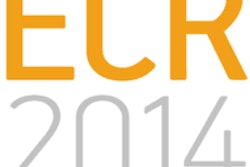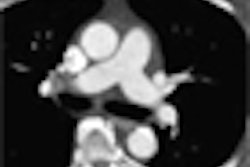SAN FRANCISCO - Can radiologists better manage adverse reactions from contrast media used during CT studies? Yes, according to a series of presentations on Tuesday at the International Society for Computed Tomography (ISCT) meeting that offered attendees strategies for reducing adverse contrast reactions.
Apart from managing radiation dose, reducing patient contrast reactions is one of the most vexing areas for radiologists. The literature is rife with conflicting studies on which patients are most at risk of developing reactions such as contrast-induced nephropathy (CIN) and when and whether to administer therapy. What's more, dueling clinical studies produce different results on the safety profiles of the various contrast agents -- with results seeming to vary based on the manufacturer that funded the study.
Fortunately, radiologists and nephrologists are beginning to hone in on a series of criteria that can be used to define which patients are most at risk of developing contrast-induced nephropathy. They are also developing new contrast administration strategies that enable radiologists to more finely adapt contrast administration profiles to the types of patients being imaged.
Contrast and kidney injury
Part of the challenge in managing contrast reactions is confusion over the seriousness of contrast-induced nephropathy. CIN is commonly defined by a rise in serum creatinine levels greater than 25%, and according to that definition it is fairly common after contrast injection. But the majority of these patients never experience the clinically significant conditions that would represent acute kidney injury (AKI), according to Dr. Steven Weisbord, a nephrologist at the University of Pittsburgh in Pennsylvania.
In a 2008 study, Weisbord's group found that while 6.5% of patients met the criteria for experiencing CIN, 2% experienced clinically significant CIN as defined by death or hospital readmission. Even though 2% might sound small at first glance, it actually can represent many patients given the large numbers of CT scans that occur -- a number that is likely to rise given the increasing incidence of diabetes and the fact that some clinicians are avoiding MRI scans in at-risk patients due to concerns over nephrogenic systemic fibrosis (NSF).
It's possible to administer preventive care in all patients scheduled for CT scans to minimize CIN, but it's not practical to do so for every patient. So radiologists need to determine which patients are most at risk. Weisbord provided five criteria for predicting clinically significant CIN:
- More advanced chronic kidney disease, as indicated by low estimated glomerular filtration rates (eGFR) at baseline measurement.
- Inpatient status. Because patients who are already hospitalized are sicker, they are much more likely to develop clinically significant CIN than outpatients undergoing CT scans. This holds true even after adjusting for comorbidity factors.
- Liver disease. Patients who have abnormal liver function are prone to abnormal kidney function or abnormal kidney injury.
- Use of loop diuretics. In the 2008 study, researchers found that patients on loop diuretics had a risk four times higher of developing clinically significant CIN (p < .05). Loop diuretics themselves probably do not cause CIN, but they could be a surrogate marker for underlying heart failure, Weisbord said.
- Diabetes. Weisbord cited a 1997 study of CIN in diabetics following coronary angiography, which found that diabetic patients with eGFR of 30 or less had dialysis rates following contrast admission from 10% to 80%.
"Presence of these risk factors should guide the use of preventive care in a resource-limited environment," Weisbord said.
When and which agent to use
In a related presentation, Dr. Myron Pozniak, a radiologist from the University of Wisconsin in Madison, discussed methods for determining when low or iso-osmolar contrast could be safely used in patients. In particular, he focused on the findings of the 2003 Nephrotoxic Effects in High-Risk Patients Undergoing Angiography (NEPHRIC) study, which showed that only 3% of patients receiving an iso-osmolar agent saw a rise in creatinine levels, compared with 26% who received a low-osmolar agent.
What's more, NEPHRIC indicated that iso-osmolar agents could be used at creatinine levels up to 3.5 mg/dL, while at the University of Wisconsin the institution limited contrast at a far lower threshold, 1.5 mg/dL. "That was a pretty shocking article, because most of us, we wouldn't even think of giving contrast to people with that kind of a creatinine level, and here this study said go ahead and do it," Pozniak said.
The NEPHRIC results prompted the facility to change its protocols to allow the use of iso-osmolar contrast in diabetics up to a creatinine level of 2.0 mg/dL, and in nondiabetics to 2.5 mg/dL. After six years the university analyzed its data, publishing results in 2009 in the American Journal of Roentgenology in a study that included 13,000 patient encounters (Bruce R et al, Vol. 192, pp. 711-718).
One surprise was that in a control group of patients who got CT but never received contrast, cases of acute kidney injury still occurred, Pozniak said. The rate of AKI in this group was identical to that of patients receiving iso-osmolar contrast, indicating that CIN rates in those getting iso-osmolar contrast are no different from background noise.
"When somebody approaches you and says that because the patient was given intravenous contrast, that contrast caused the acute kidney injury -- it's not proven," Pozniak said. The injury could have been caused by other drugs or another cause, he said.
There were higher rates of AKI in patients receiving low-osmolar agents, with the cutoff at a creatinine level of 1.8 mg/dL. This led the University of Wisconsin to lower its threshold for the use of low-osmolar agents in these patients.
The university's policy now allows for the use of iso-osmolar contrast in patients with modest renal impairment. These patients should still receive hydration and other monitoring, Pozniak said. Contrast is not provided to diabetics with a creatinine higher than 2.0 mg/dL, but for nondiabetics, the university uses low-osmolar agents for those with creatinine levels up to 1.8 mg/dL, and it uses iso-osmolar contrast from 1.8 mg/dL to 3.0 mg/dL, approaching the level used in the NEPHRIC study.
In a final presentation on the contrast reactions track, Weisbord returned to the podium to discuss how to best evaluate patients to estimate risk for CIN prior to contrast-enhanced CT. He said that clinicians should consider measuring a patient's serum creatinine if they have any one of the following characteristics: known renal insufficiency, diabetes mellitus, heart failure, proteinuria, age older than 65, hypertension, nephrotoxic drug use, a history of kidney problems after contrast, or advanced liver disease.
It's best to measure serum creatinine as close as possible to the time of the CT scan, and in severely ill patients, changes in creatinine levels are often just as important as the levels themselves, he said. He also reiterated his earlier advice, in that inpatients are much more likely to experience acute kidney injury than outpatients.
Neither Weisbord nor Pozniak reported any financial relationships with commercial interests related to the content of their presentations.
By Brian Casey
AuntMinnie.com staff writer
May 19, 2010
Related Reading
High glucose signals contrast risk in angio patients, March 31, 2010
Coronary CT angiography identifies high-risk diabetics, March 18, 2010
ACC: Cardiac cath contrast has low adverse reaction rates, March 17, 2010
Iodixanol and iopamidol show similar nephrotoxicity, November 25, 2009
Study: Iso-osmolar contrast not safer for kidneys, July 30, 2009
Copyright © 2010 AuntMinnie.com



















